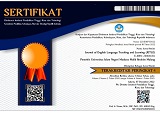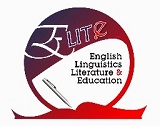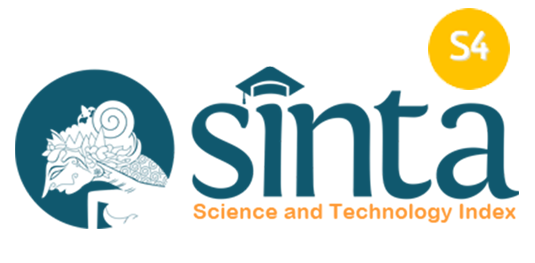THE ANALYSIS OF STUDENTS’ PRONUNCIATION ERRORS IN READING ALOUD
Abstract
Full Text:
PDFReferences
Boey, L. K. (1975). An Introduction to Linguistics for the Language Teacher. Singapore: University Press.
Brown, H. (1994). Teaching by Principle : An Interactive Approach to Language Pedagogy. San Fransisco State Universuty: Prentice Hall Regents.
Carl F. Auerbach, L. B. (2003). Qualitative Data. New York: New York University Press.
Corder, S. P. (1972). Error Analysis ; Perspectives on Second Language Acquisition. Oxford: Oxford University Press.
Creswell, J. W. (2009). Research Design ; Qualitative, Quantitative, and Mixed Methods Approaches. London: SAGE.
Dawson, D. C. (2002). Practical Research Methods. United Kingdom: How to books.
J.D. O, c. (1967). Better English Pronunciation. New York: The Press Syndicate of the University of Cambridge.
J.D.O'connor. (1967). Better English Pronunciation. London: Cambridge Universuty Press.
L.Stoller, W. G. (2002). Teaching and Researching Reading. London: Pearson Educational Longman.
McMahon, A. (2002). Phonetics and Phonology : Reader for First Year English Linguistics. Edinburgh: Edinburgh University Press.
Muijs, D. (2004). Doing Quantitavue Reaserch in Education. London: Sage Publications.
Rahayu, N. (2012). The Use of Communicative and Interactive Drill Technique in Increasing Students'Pronunciation Mastery Vocational High. Garut: STKIP.
Schmitz, C. H. (2005). Phonetics and Phonology : Reader for First Year English Linguistics. Oldenburg: University of Oldenburg.
DOI: https://doi.org/10.18860/jetle.v1i1.7761
Refbacks
- There are currently no refbacks.
Jalan Gajayana 50 Malang 65144, Jawa Timur, Indonesia

This work is licensed under a Creative Commons Attribution-ShareAlike 4.0 International License.
Indexed by





